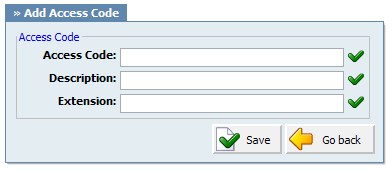The only difference between standard and multi-digit IVRs is that the latter accepts two or more digits as a respons (numbers between 10-100 for example), therefore providing a wider range of options.
This screen lists all system Multi-digit DIDs with the following details:
Table 7.11. Multi-digit IVR codes
| Field |
Description |
Example |
Field Type |
|
Access Code:
|
Multi-digit IVR access code |
22 |
Display |
|
Description:
|
Access code description |
desc goes here |
Display |
|
Extension:
|
Extension where call will be transferred to |
1004 |
Display |
|
|
Edits the IVR configuration |
Click to edit IVR configuration |
Button |
|
|
Deletes an IVR from the system |
Click to delete an IVR from the system |
Button |
Table 7.12. Search
| Field |
Description |
Example |
Field Type |
|
Search:
|
Search phrase |
Provide a search phrase here and hit enter to filter the records |
[a-z][0-9] |
|
Access Code:
|
Should search filter be applied to access codes |
Check the box to search access codes |
Check box |
Table 7.13. Add/Edit Access Code
| Field |
Description |
Example |
Field Type |
|
Access code:
|
Option dialed from the Multi-digit IVRs that will transfer user to PBXware 'Extension' number. |
John enters the Multi-digit IVR and dials this 'Access Code' (e.g. 99). When John dials 99, he will be transferred to PBXware 'Extension' number |
[0-9] |
|
Description:
|
A short Description of this access code and its destination. This information is view only by the Administrator |
Once the administrator goes to the 'PBXware: Multi-digit IVR codes', a list of access codes, their descriptions and destination extensions will be displayed. |
[0-9] |
|
Extension:
|
PBXware extension to which a call will be transferred to once the 'Access code' is dialed from the Multi-digit IVR |
John enters the multi-digit IVR and dials 99, which is set to lead to PBXware extension 1000. When John dials 99, he will be transferred to PBXware 'Extension' provided here |
[0-9] |




